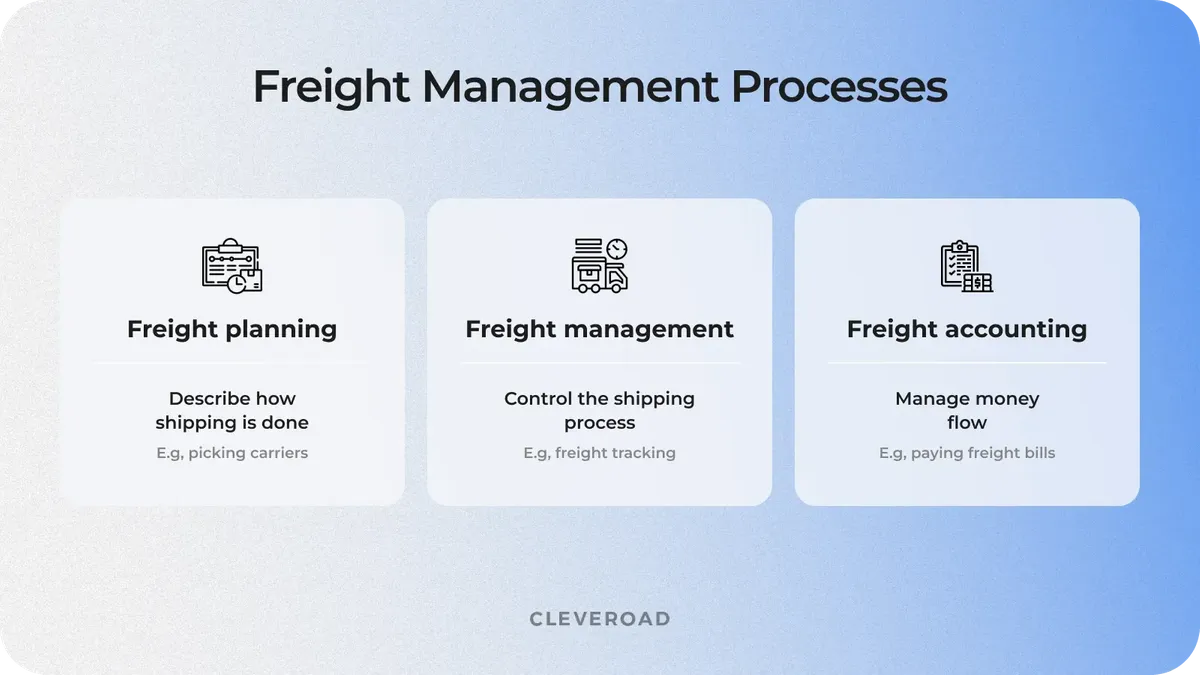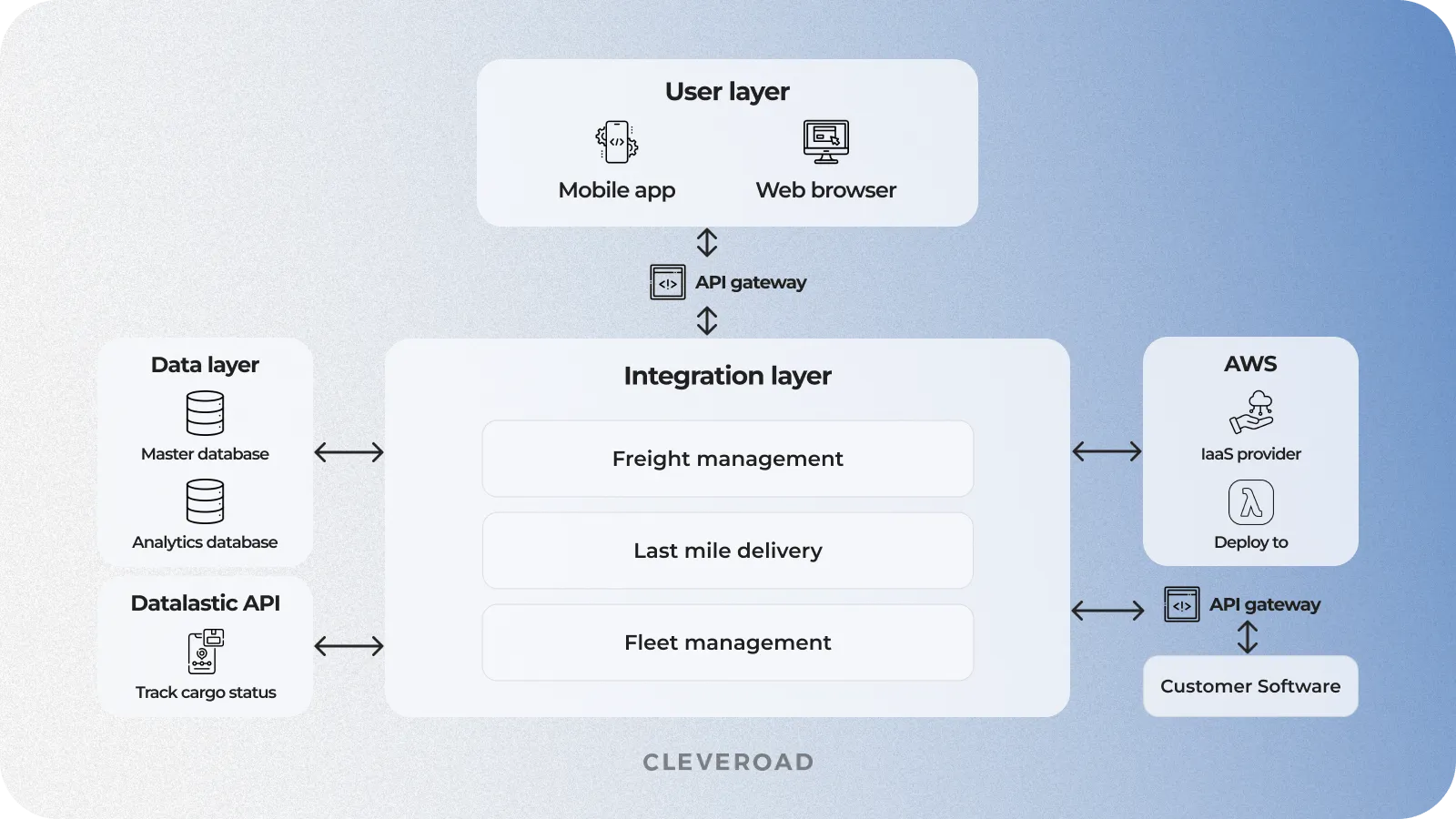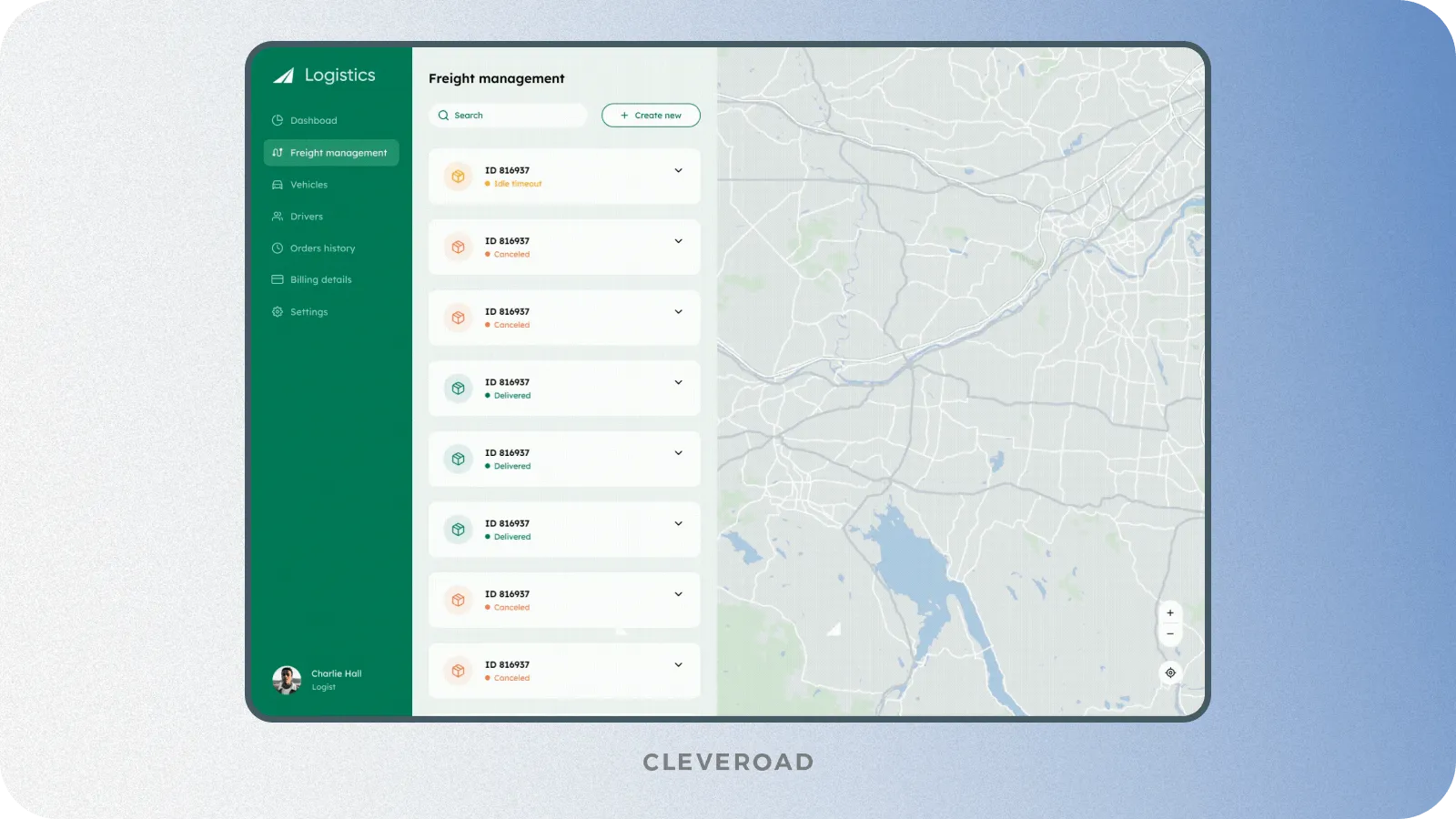Freight Management Systems: How They Help Improve the Transportation Business
Updated 15 Jan 2024
18 Min
1603 Views
Every day millions of diversified freight move around the world, but how would you know you’ve picked the most efficient way to move it? The flow of digitalization and specialized software implementation can help you address this concern.
Freight management software is a beneficial solution for freight and transportation companies to improve cargo planning, optimize shipments for cost-effectiveness, simplify the RFP process with carriers, and automate document flow. The freight management system market is projected to grow with a CAGR of over 9% between 2023 and 2032, so you have considerable opportunities to make money quickly. Growing transportation challenges, an increase in global trade, and rising logistics costs only reinforce the need for digitized solutions in the freight industry.
This post will discuss the essence of the freight management systems and how to bring added business value through their implementation.
What Is Freight Management System and How Is It Used?
Freight Management System (FMS) stands for the robust platform that allows the user to address critical tasks referring to freight movements. It’s built to help transportation companies automate and optimize the shipping process, track deliveries, compare the carrier rates, search all transportation modes, and elude the endless paper trail.
Maryna Kurlovych
Cleveroad’s Logistics Expert
"Freight Management Software is a game-changer in logistics, optimizing operations, enhancing connectivity, minimizing costs, and fostering seamless collaboration within the trade network."
As a part of logistics flow, freight management covers the whole supply chain process from warehousing to inventory management and client network collaboration. But what is freight management system and which operations does it handle? Here is an overview of freight management flow:
1. Carrier selection: The critical task of choosing the most favorable carrier based on freight rates, terms, and service expectations.
2. Optimizing cargo routes: Every shipping company aims to identify the most cost-effective route for transporting their cargo. This entails activities like selecting the optimal transportation mode(s), assigning vehicles and drivers, and ensuring a balanced cargo load.
3. Scheduled pickup: Scheduling and coordinating pickups are a crucial part of freight management to ensure timely and efficient cargo transportation.
4. Managing documentation and regulations: This operation involves the preparation of necessary paperwork, insurance oversight, and ensuring compliance with government regulations.
5. Freight tracking and tracing: This function revolves around ensuring the visibility of freight. Typically, third-party carriers offer vehicle tracking, while some systems allow individual tracking.
6. Analytics: Harnessing insights from the collected data to refine and enhance the efficiency of your shipping processes.

Freight management process overview
In addition to optimizing supply chain management, the freight management software provides smooth connections between key stakeholders: shippers, freight forwarders, carriers, and receivers. Generally, the system is connected to ERP (enterprise resource planning) from the inside and linked to carriers from the outside. Here’s a standard scheme on how it works:
- When you have items that need to be delivered, the freight management system generates a pickup request. Some queries are scheduled upfront and some work on a one-time basis.
- The system then displays a list of suitable and available carriers depending on defined parameters. You can select the carrier manually or allow the program to auto-pick the best deal.
- The forwarder/shipper can then verify if the carrier is available and book the load and pickup time.
- A shipper or a broker gets information about the distribution of cargo, assigned carrier, and vehicle, affirm it, and the carrier signs the (digital) bill of lading.
- A shipper can monitor the freight on the route and submit this information to the client in real-time.
- After the consignee assumes the cargo, the trucking agency is invoiced for its services.
Businesses that rely on freight management
Within the freight management system, there is a wide range of management disciplines, each used to meet a unique set of logistical challenges. Here we look at the various freight management systems and the features that set them apart.
Domestic freight management
Freight management on a domestic level is concerned with the transportation of commodities within a given country or region. In other words, managing the flow of goods from domestic producers to domestic consumers or sellers is what domestic logistics entails.
International freight management
This involves managing freight across international borders. The process primarily entails handling import and export operations, adhering to customs laws, liaising with international transporters, and guaranteeing adherence to all relevant regulations.
Third-Party Logistics (3PLs)
3PL management entails managing orders for online stores. In this process, goods ordered via e-commerce platforms are stored, picked, packed, and sent. Other aspects of this management include inventory processing, order tracking, and handling returns.
E-commerce fulfillment management
This management entails managing orders for online stores. In this process, goods ordered via e-commerce platforms are stored, picked, packed, and sent. Other aspects of this management include inventory processing, order tracking, and handling returns.
Reverse logistics management
Reverse logistics management deals with the repair and recycling of returned goods. It includes processing returned items, monitoring warranty claims, reconditioning products, and assuring safe waste disposal and recycling.
How Can FMS Optimize Freight Management?
Freight management software will be advantageous for transportation companies as it increases the entire logistics system productivity. Let's explore how a Freight Management System (FMS) simplifies your tasks through freight software, offering you features that assist and automate next processes:
Optimizing load and routing
When determining the best path for your shipment, various factors like distance, vehicle constraints, and traffic data come into play. This analysis aids in selecting a route that ensures faster and cost-effective delivery.
Irrespective of whether you choose a private or third-party shipping provider, the goal is always to transport more goods in less time and with fewer vehicles or containers. This is particularly crucial for third-party carriers, as it's at the core of their operations. Truck drivers also utilize specialized apps that allow them to navigate weighing stations legally, saving time and ensuring your delivery arrives as scheduled. Load planning software runs in tandem with route optimization software because shippers aim to expedite unloading.
Freight management software comes equipped with an integrated load planning tool that contains freight costs and truckload information. This functionality benefits all shippers, but it holds particular significance for Less-Than-Truckload (LTL) shippers who consolidate goods from multiple customers in a single trailer.
Monitoring and tracing shipments
You have the capability to monitor and track your consignment, which includes the truck or carrier transporting it within the Freight Management System. What could be more reassuring than knowing the exact location of your shipment? You can effortlessly pinpoint the physical whereabouts of your goods with a simple tap on the application. The tracking methods at your disposal include GPS, Barcodes, and RFID, depending on the service levels of detail you require about your shipment. For transporting valuable or sensitive items, you can even monitor the temperature within the trailer and check the status of door sensors.
While it's currently not feasible to track individual packages within the trailer, the overall visibility provides a strong sense of reliability and peace of mind. This visibility enables you to plan your shipments effectively and eliminates the risk of delayed deliveries, all within the framework of trust provided by cargo software, without the need to directly contact the drivers
Documentation and regulatory compliance
Shippers often find themselves grappling with the intricacies of paperwork and adhering to stringent regulations, sometimes overshadowing their primary concern of safeguarding goods during transportation. The complex regulatory landscape within the transportation industry is a pivotal aspect of overall freight logistics management. The last thing anyone desires is a shipment delay or seizure due to inadequate documentation. Fortunately, freight and logistics software streamlines this process by offering digital signatures for a range of critical documents, including invoices, waybills, bills of lading, custom invoices, certificates of origin, and various other essential paperwork.
Additionally, fleet management systems facilitate swift and digital claims processing, mitigating potential losses resulting from third-party incidents. This digital accessibility and functionality not only save valuable time but also eliminate the need for labor-intensive visits to shipping companies to process claims. Freight accounting is a continuous and around-the-clock operation in the shipping and transportation industry. The invoices for the services rendered to you are dispatched to your accounting department and securely archived.
A multitude of expenses is associated with the transportation system. Here's a breakdown for your reference:
- Receiving freight invoices: These documents contain fundamental shipment details that must align with the bill of lading. You can generate these invoices directly within the freight logistics software.
- Obtaining freight costs and quotes: This entails procuring shipping rates provided by carriers through transportation dispatch software.
- Processing freight and shipping invoices: Once audited, the bills are integrated into the accounting system and scheduled for payment.
- Executing freight payments: This service involves settling the transportation invoices efficiently.
- Freight in/out expenses: This encompasses the transportation expenses incurred when receiving goods in the warehouse and delivering them to the end consumer or customer
How Can FMS Be Deployed in a Logistics Company?
Freight management software can be presented as a standalone solution (SaaS platform) or part of a transportation management system (TMS). Shippers often rely on transportation management software to book carriers, trail shipments in real-time, auto-reconcile freight invoices, get valuable insights based on thorough data analysis, etc. In this matter, the system acts as one of the TMS modules addressing all the logistics management-related issues. Meanwhile, carriers tend to apply dedicated SaaS (Software as a Solution) platforms for dispatching and optimizing routes. Such solutions can also be of benefit to retailers, distributors, and manufacturers.
Freight management software as SaaS is a cloud-based solution that helps users streamline freight delivery operations with multiple digital solutions. These systems can be employed to set up FLT (full truckloads shipping), LTL (less-than-truckload shipping), multimodal, intermodal optimization, and other services. The freight management software itself came as a much lower logistics solution than purchasing full-fledged TMS systems. An investment in a standalone freight management program is a beneficial idea for small and medium organizations to eliminate the hassle of some logistics-related processes, such as:
- Freight planning
- Coordination between stakeholders,
- Regulation compliances
- Claims management, etc.
In turn, the transportation management system is an end-to-end solution that works perfectly for enterprise-level logistics companies to manage different stages of the supply chain: from route planning to fleet management system development and driver control.
Read our full guide on transportation management systems development: what are they and why logistics businesses need them
List of freight management system business roles
Now, let’s see how the freight management system interacts with supply chain participants.
Each system user can belong to several access groups. Different modes of freight administration exist to meet the wide range of logistical demands. As a result, you should look into your transportation options and hire the best company possible. Let's explore user groups and their purposes:
| User role | Responsibilities |
Administrator |
|
Dispatcher |
|
Driver |
|
Accounting |
|
Warehouse Staff |
|
Key Modules of the Freight Management System
Freight management software typically functions to optimize freight transportation. Let’s find out what key modules are required for this purpose.
Freight modes
There are four major types of freight transportation available for shippers to use in the world of freight shipping. The primary ones are by ground (road), rail, ocean, and air. Although these are the main categories of freight transportation, each method has their own processes that differ from one another
Freight management
The process of efficiently and strategically moving freight across a network from its point of origin to its desired destination using various modes of transportation, intermediaries, and technologies.
Customer management
The processes, practices, systems, and applications that a company uses to manage its relationships with existing customers and new prospects. A customer management strategy can build lasting customer relationships and grow your business.
Emergency contact
Your phone can automatically send its location to emergency response partners when you call or text an emergency number. It uses the device location and Google Location Accuracy even if those settings are disabled.
Routing & dispatch
Autonomous dispatch and route optimization app is an automated system that coordinates the movement of people, goods, and services to improve fleet efficiency and utilization, improve customer service, minimize the time spent on route planning, and reduce late deliveries.
Fuel control
Monitor and control fuel consumption within your fleet. They accurately measure and track fuel inventories and how fuel is dispensed. This information is then stored in systems and reported to the manager through the use of web portals to provide this useful data.
You can also turn to a fleet management software development to get a separate solution for fleet management and fuel control. It will allow you to efficiently monitor and optimize both your vehicle fleet and fuel consumption, enhancing overall operational control and cost-effectiveness.
Smart schedule
The term smart scheduling refers to the use of data and technology in assigning work. It provides your back office and field service workers with a clear line of communication while also giving them the tools and data to be more efficient in their daily tasks.
Automatic notifications
Allows organizations of all sizes to share information instantaneously with hundreds or thousands of recipients. Some services also offer the flexibility to send messages to defined lists or groups of contacts, which improves relevancy.
Invoice generation
Invoice generator lets you instantly make invoices with our attractive invoice template straight from your web browser. The invoices you make can be sent and paid online or downloaded as a PDF.
Document management
The transportation industry is firmly regulated and deals with loads of paperwork. The FMS lets shippers enter information on papers, download, email all the needed documents, as well as process claims. The system also involves interfaces for data capture and document sharing to ensure the transported items are compliant with government regulations (including cross-border compliances).
Notice: Each module consists of various features. The number of modules and features can vary depending on the business-specific tasks and needs. You can book a meeting with our Logistics experts to define the feature set tailored to your transportation needs.
Freight Management System in Action: Solution Demo
Planning to build your own freight management system, you probably want to see it in action to get a sense of its capabilities. Our team has designed a demo version of the solution, so you can see how the software for freight management works.

How to Implement FMS in Your Business to Get the Most Out of It
After you’ve figured out how your company can win from freight management solutions, the next question arises: “How to develop and implement it into business operations?” We’ve prepared a step-by-step approach to software implementation success.
Establish business strategy
Firstly, you need to define your product’s requirements and goals: what business challenges you want to solve. For example, you want to increase transparency throughout the freight movements to have better control of assets. Or you may need a unified communication platform for all stakeholders. Understanding what business issues have to be addressed would set the direction for further development.
Choose a credible vendor
When looking for a tech partner to get high-quality freight management system development services, keep tabs on the number of successful projects, their complexity, and what technologies were used during the development processes. Besides, pay attention to the vendor's expertise to ensure the company has hands-on experience in Logistics software development services. There are many hiring platforms, like Clutch, where you can find information about the company services, budgets, and clients’ feedback.
Outsourcing is considered the most beneficial approach to enterprise-level app development. In this case, you get access to a wide range of skills and unique expertise. Outsourcing companies already have a team of experienced specialists who will rapidly deliver your freight management software in tune with your budget, time, and demands. Moreover, with outsourcing, you only pay for the work to be done without extra expenses. Thus, the software development cost is reduced, the execution and product quality keep flawless.
Even though technology consulting rates vary depending on the country, Central and North Europe seem a golden means in terms of price. For example, you can outsource app development services to Estonia to get lower rates and high developer qualifications. In addition, there are many reliable software development companies that can deliver custom logistics software solutions for approximately $50 to $80 per hour. In comparison, the software development rates in the United States range from $120-300 per hour for the same quality level.
Build a FMS with skilled vendor
Cleveroad experts are ready to build freight management system fitting your transportation needs
After you have selected several suitable vendors, it is worth sending them a request for proposal for software development with a description of your project. In this document, indicate the requirements for the finished product, possible limitations, and your vision of the result. Describe your company, industry, and business goals: it will help providers better understand what you need and offer an appropriate solution.
Assembling project requirements
This phase is also called the Discovery Phase. Logistics Business Analysts scrutinize your business needs, user and tech requirements. After all the input data is examined, BA draws up the detailed project specification along with a clear development and implementation plan. This document details all the system peculiarities, like features, tech stack, shipping API integration, etc. You should also select software architecture based on your platform and non-functional requirements. Since logistics solutions relate to complex interconnected systems, it’s oftenly better to implement microservices architecture to be able to scale your app up and down depending on your requirements.

Example of freight management system architecture made by Cleveroad
Development and integration
During this stage, the team of software developers builds a backend and frontend of your freight management system as well as a mobile application for drivers and logistics managers. Mobile apps are useful both for transportation companies and end customers. For example, it may include functionality, allowing freight agents to use a digital footprint to any freight item through checkpoint scan or the ability to receive clients’ signatures at the place of delivery.
Cleveroad's business analyst team compiled the essential technical prerequisites for a robust FMS:
- Access to third-party integration. In today's interconnected business environment, the ability to seamlessly integrate with third-party systems is paramount. Your freight management system should facilitate easy access to integration with different platforms, enabling data exchange, synchronization, and collaboration with external systems.
- API integration (application programming interface). APIs are the conduits for communication between software components. Your freight management system software should provide a well-documented API to allow for smooth connectivity with other systems, applications, and services. This feature is essential for sharing data and facilitating efficient data flow.
- Real-time monitoring. Real-time monitoring is a critical component for ensuring the efficient and responsive management of freight. Your freight management software should offer real-time monitoring capabilities, allowing users to track shipments, view status updates, and address issues promptly. This feature empowers businesses to make informed decisions and respond to changes.
- Transportation management. Effective transportation management is at the core of an efficient freight management system. The system should offer tools for planning, optimizing, and managing the movement of goods. This includes features such as route optimization, carrier selection, and load balancing to maximize transportation efficiency.
- Status tracking. A key requirement for an effective freight management software is the ability to track and report on the status of freight shipments. This includes tracking cargo in transit, providing real-time updates, and offering a user-friendly interface for customers to access status information. The system should also have the capability to manage exceptions and provide notifications.
Incorporating these technical requirements into your Freight Management System ensures that your solution is well-equipped to meet the diverse needs of your business in the complex world of freight management.
Since a freight management solution usually involves the synchronization of operations between different departments of transport and logistics companies, their development is a rather complex and lengthy process that requires extra resource costs. Developers can simplify this task using third-party integrations.
Below, you are welcome to view the most popular solutions for such integrations:
| Third-party integrations | Description |
Automated Order Processing | Seamlessly import online store orders into FMS, saving time and reducing picking errors. |
Rate Shopping | Analyze shipping options based on various parameters to select the most cost-effective choice, saving costs and offering competitive rates to customers. |
Label Printing | Print labels for parcel carriers and Bills of Lading for different carriers, ensuring accurate labeling and delivery. |
Real-Time Tracking | Provide customers with automatic, real-time updates on their shipments, enhancing the overall shopping experience and reducing anxiety. |
Automated Notifications | Send timely shipping notifications and updates to customers, reducing inquiries and improving customer service. |
Predictive Analytics | Anticipate shipping demand and optimize logistics operations in real-time. |
AI-driven Customer Service | Utilize AI for personalized recommendations and support, enhancing the customer experience. |
Data-driven Tailoring | Use data gathered by logistics software to tailor shipping options and carriers to individual customer preferences. |
Maintenance and scalability
The cooperation with your vendor doesn't finish with the final stage. Due to system complexity, it may require multi-tier technical support options and maintenance services. This work may include support for the integrated software, version updates, adding new functionality, code optimization, etc. These actions will contribute significantly to freight management system scalability, and your app will be able to keep up with the dynamic market and changing shipping needs.
Cleveroad — Your Reliable Tech Partner in FMS Development
Cleveroad is a professional web and mobile development company from the CEE region (Central and Eastern Europe) , helping businesses to deliver custom software solutions. With over 12+ years in software development, we have built up expertise in multiple domains, among which Logistics occupies a leading position.
Our team has in-depth competence in the creation of Logistics Management Systems, like Transportation Management System (TMS), Supply Management System (SCM), Enterprise Resource Planning (ERP), and other custom logistics software. We start cooperation with in-depth business analysis to guarantee you concrete business values and high-quality outcomes.
Collaborating with us, you’ll obtain:
- In-depth, solid software development experience in various business fields
- A consultation about your project with our Solution Architect and Business Analysts
- Full-service development, including UI/UX design, DevOps services, legacy software modernization, and other IT services in one place
- Signing Non-Disclosure Agreements (NDA) per your request
- Innovative development approaches and a cutting-edge tech stack
- Flexible cooperation models: dedicated team, fixed price, time & materials
Our team has built and released many software solutions for logistic companies for this time. One of the latest cases is the transportation management solution for logistics company. The platform has a built-in automated route planning module to cut costs on planning, optimize fuel management, and create an organic and coordinated logistics ecosystem.
We’ve successfully delivered end-to-end TMS, including the following modules (but is not limited to them):
Fleet management module
Helps the company track and manage fleets. For example, fleet managers can create a group of vehicles utilized in transportation flow and modify it due to changing business processes.
Delivery points management module
Allows TMS users to determine everyday work location and track data changes in real-time.
Access system for company staff
Enables access level management according to the employees’ role RBAC approach.
“Jobs for delivery” module
This functionality allows integration with existing WMS and CRM systems for smooth data transmission.
Route planning mobile app
Makes it possible for truck drivers to navigate through custom routes.
Make your transportation services more effective by benefiting from our hand-on experience. You’ll get a sought-after logistics solution, allowing you to increase your business performance by automating the shipping process and streamline communication between stakeholders.
Improve your freight management
Get full-fledged logistics software development services to boost your freight delivery operations
A Freight Management System (FMS) automates and optimizes freight and logistics operations, including automated order processing, rate shopping, label printing, real-time tracking, and predictive analytics. It enhances efficiency, reduces errors, and improves customer experience.
Freight management system (FMS) is a platform that allows the user to address critical tasks referring to freight movements. It’s built to help transportation companies automate and optimize the shipping process, track deliveries, compare the carrier rates, search all transportation modes, and elude the endless paper trail.
Freight management in logistics is where a shipper employs a logistics service provider (LSP) to effectively and strategically transfer freight across its network of clients (outbound) and vendors (inbound) applying different modes of transportation, intermediaries, and technologies by using their logistics and supply chain expertise and assets.
To implement FMS you should perform several important steps:
- Set goals and clarify your business needs.
- Find experts; consider outsourcing to experienced vendors.
- Plan and thoroughly detail project requirements.
- Build & optimize: develop backend, frontend, and apps. Address key technical needs.
- Ensure ongoing support and scalability.
Freight management software will be advantageous for transportation companies as it increases the entire logistics system productivity. It allows shippers to keep all operations synchronized, improve communication process between all participants involved, increase traceability and visibility over deliveries, simplify the carrier selection, enhance data-driven decision-making, and much more.
Freight management systems can provide various advantages, including:
- Optimizing load and routing
- Monitoring and tracing shipments
- Documentation and regulatory compliance
- Receiving freight invoices

Evgeniy Altynpara is a CTO and member of the Forbes Councils’ community of tech professionals. He is an expert in software development and technological entrepreneurship and has 10+years of experience in digital transformation consulting in Healthcare, FinTech, Supply Chain and Logistics
Give us your impressions about this article
Give us your impressions about this article

